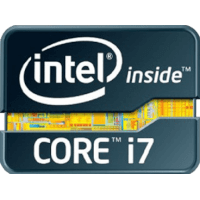
The processor Intel Core i7-3820QM is developed on the 22 nm technology node and architecture Ivy Bridge H. Its base clock speed is 2.70 GHz, and maximum clock speed in turbo boost - --. Intel Core i7-3820QM contains 4 processing cores. To make a right choice for computer upgrading, please get familiar with the detailed technical specifications and benchmark results. Check socket compatibility before choosing.
 CPU Cores and Base Frequency CPU Cores and Base Frequency |
||||
|---|---|---|---|---|
| Frequency | 2.70 GHz | Cores | 4 | |
| Turbo (1 Core) | 3.70 GHz | CPU Threads | 8 | |
| Turbo (All Cores) | -- | |||
| Hyperthreading ? | Yes | Overclocking ? | Yes | |
| Core architecture | normal | |||
 Internal Graphics Internal Graphics |
|
|---|---|
| GPU name | Intel HD Graphics 4000 |
| GPU frequency | 0.65 GHz |
| GPU (Turbo) | 1.25 GHz |
| Generation | |
| DirectX Version | 11.0 |
| Execution units | 16 |
| Shader | 128 |
| Max. Memory | 2 GB |
| Max. displays | 3 |
| Technology | 22 nm |
| Release date | Q1/2011 |
 Hardware codec support Hardware codec support
|
|
|---|---|
| H264 | Decode / Encode |
| H265 / HEVC (8 bit) | No |
| H265 / HEVC (10 bit) | No |
| VP8 | No |
| VP9 | No |
| AV1 | No |
| AV1 | No |
| AVC | Decode / Encode |
| JPEG | Decode |
 Memory & PCIe Memory & PCIe
| ||||
|---|---|---|---|---|
| Memory type | DDR3-1333DDR3-1600DDR3L-1333 SO-DIMMDDR3L-1600 SO-DIMM | |||
| Max. Memory | 32 GB | |||
| Memory channels | 2 | ECC | No | |
| PCIe version | 3.0 | PCIe lanes | 16 | |
 Thermal Management Thermal Management
| ||||
|---|---|---|---|---|
| TDP (PL1) | 45 W | TDP (PL2) | ||
| TDP up | -- | TDP down | -- | |
| Tjunction max | 105 °C | |||
 Technical details Technical details
| |
|---|---|
| Instruction set (ISA) | x86-64 (64 bit) |
| Architecture | Ivy Bridge H |
| L2-Cache | -- |
| L3-Cache | 8.00 MB |
| Technology | 22 nm |
| Virtualization | VT-x, VT-x EPT, VT-d |
| Release date | Q2/2012 |
| Socket | BGA 1224 |
Geekbench 5 is a cross plattform benchmark that heavily uses the systems memory. A fast memory will push the result a lot. The single-core test only uses one CPU core, the amount of cores or hyperthreading ability doesn't count.
Geekbench 5 is a cross plattform benchmark that heavily uses the systems memory. A fast memory will push the result a lot. The multi-core test involves all CPU cores and taks a big advantage of hyperthreading.
The theoretical computing performance of the internal graphics unit of the processor with simple accuracy (32 bit) in GFLOPS. GFLOPS indicates how many billion floating point operations the iGPU can perform per second.